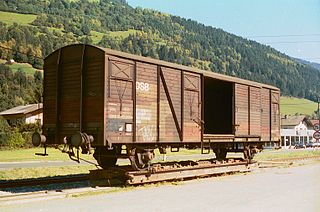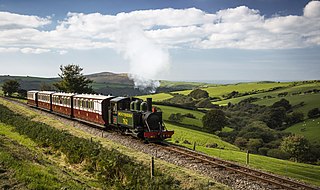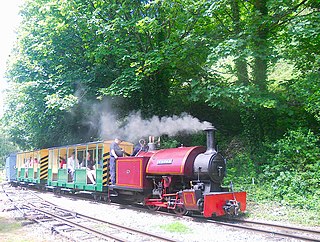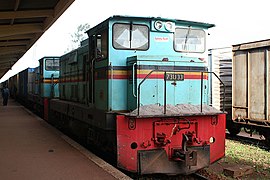
N scale is a popular model railway scale. Depending upon the manufacturer, the scale ranges from 1:148 to 1:160. Effectively the scale is 1:159, 9 mm to 1,435 mm, which is the width of standard gauge railway. However the scale may vary to simulate wide or narrow gauge rail. In all cases, the gauge is 9 mm or 0.354 in. The term N gauge refers to the track dimensions, but in the United Kingdom in particular British N gauge refers to a 1:148 scale with 1:160 track gauge modelling. The terms N scale and N gauge are often inaccurately used interchangeably, as scale is defined as ratio or proportion of the model, and gauge only as a distance between rails. The scale 1:148 defines the rail-to-rail gauge equal to 9 mm exactly, so when calculating the rail or track use 1:160 and for engines and car wheel base use 1:148.

OO9, often also denoted as 009 or 00-9 and commonly pronounced as Double-Oh Nine, is a model railway scale and gauge combination of 4 mm scale and 9 mm gauge tracks, which models a prototype track gauge of 2 ft 3 in. It is a common choice in the United Kingdom for the modelling of narrow-gauge railways whose prototype gauges lie approximately between 2 ft and 2 ft 6 in. The 9 mm track gauge is used by N gauge model railways, a common commercial scale, which means that a selection of wheels, track, and mechanisms is readily available.

A coupling or coupler is a mechanism, typically located at each end of a rail vehicle, that connects them together to form a train. The equipment that connects the couplers to the vehicles is the draft gear or draw gear, which must absorb the stresses of the coupling and the acceleration of the train.

A transporter wagon, in railway terminology, is a wagon (UIC) or railroad car (US) designed to carry other railway equipment. Normally, it is used to transport equipment of a different rail gauge. In most cases, a transporter wagon is a narrower gauge wagon for transporting a wider gauge equipment, allowing freight in a wider gauge wagons to reach destinations on the narrower gauge network without the expense and time of transshipment into a narrower gauge wagons.

With railways, a break of gauge occurs where a line of one track gauge meets a line of a different gauge. Trains and rolling stock generally cannot run through without some form of conversion between gauges, leading to passengers having to change trains and freight requiring transloading or transshipping; this can add delays, costs, and inconvenience to travel on such a route.

The Lynton and Barnstaple Railway (L&B) was a single track, 1 ft 11+1⁄2 in narrow gauge railway. It opened in May 1898 and ran for slightly more than 19 miles (31 km) through the area bordering Exmoor in North Devon, England. Although it opened after the Light Railways Act 1896 came into force, it was authorised and constructed before that act. It was authorised under its own Act of Parliament and built to higher standards than similar railways of the time. It was notable as the only narrow gauge railway in Britain that was required to use main-line standard signalling. For a short period, it earned a modest return for shareholders, but for most of its existence it made a loss. In 1923, the L&B was taken over by the Southern Railway, and eventually closed in September 1935.

A buffer is a part of the buffers and chain coupler system used on the railway systems of many countries, among them most of those in Europe, for attaching railway vehicles together.
The African Union of Railways is an organisation under the auspices of the new African Union dealing with railways. It is similar to the International Union of Railways (UIC).
The Rolling stock of the Lynton and Barnstaple Railway was one of the most distinctive aspects of the 1 ft 11+1⁄2 in narrow gauge line which ran for almost twenty miles across Exmoor in North Devon, England, from 1898 to 1935.

The former Victorian Railways, the state railway authority in Victoria, Australia, built a number of experimental 2 ft 6 in narrow-gauge lines around the beginning of the 20th century. Although all were closed by the early 1960s, parts of two have been reopened as heritage railways.
The Creekmoor Light Railway was a small, privately run, 2 ft narrow gauge railway. It was situated off Creekmoor Lane, to the north of Poole, between Broadstone and Fleetsbridge, Dorset, and was operated by a group of local enthusiasts from October 1968, to April 1973.
The railcar couplers or couplings listed, described, and depicted below are used worldwide on legacy and modern railways. Compatible and similar designs are frequently referred to using widely differing make, brand, regional or nick names, which can make describing standard or typical designs confusing. Dimensions and ratings noted in these articles are usually of nominal or typical components and systems, though standards and practices also vary widely with railway, region, and era. Transition between incompatible coupler types may be accomplished using dual couplings, a coupling adapter or a barrier wagon.

The Amberley Museum Railway is a 2 ft narrow gauge railway based at Amberley Museum, Amberley, West Sussex. It has a varied collection of engines and rolling stock ranging from 18 in gauge to 5 ft 3 in gauge. It operates passenger trains at the museum using a mixture of steam, internal combustion and battery-electric locomotives.
Steam traction was the predominant form of motive power used by the Deutsche Reichsbahn on its narrow-gauge railways. For certain duties diesel locomotives were also used, albeit these were usually second-hand or rebuilt engines.
Knuckle couplers are a semi-automatic form of railway coupling that allow rail cars and locomotives to be securely linked together without rail workers having to get between the vehicles.
From time to time, a railway decides that it needs to upgrade its coupling system from one that is proving unsatisfactory, to another that meets future requirements. This can be done gradually, which can create many problems with transitional incompatibilities, or overnight, which requires much planning.

Buffers and chain couplers – also known as "buffers and screw", "screw", and "screwlink" – are the de facto International Union of Railways (UIC) standard railway coupling used in the EU and UK, and on some railways in other parts of the world, such as in South America and India, on older rolling stock. Buffers and chain couplers are an assembly of several devices: buffers, hooks and links, or turnbuckle screws.

750 mm narrow-gauge railways are very similar to 760 mm and 2 ft 6 in gauge. 750 mm gauge rolling stock is almost compatible with 760 and 762 mm railways.

Different types of railroad rolling stock have different couplers depending on the purpose and type of equipment being used and its intended destination. European rolling stock tend to use buffers and chain couplers while American rolling stock uses a Janney coupler or "knuckle coupler". These are incompatible with each other, but where some railroads have obtained older, less expensive used rolling stock from different countries or regions, instead of having to standardize on one form of coupler, it may be useful to be able to use either type of coupler on a piece of rolling stock without having to remove anything.

The balance lever coupling, also known as rocking lever coupling or compensating coupling, is a type of central buffer coupling that has found widespread use, especially in narrow-gauge railways. In Switzerland this type of coupling is called a central buffer with two screw couplings, abbreviated to Zp2, or referred to as a central buffer coupling with coupling hooks on the side




















